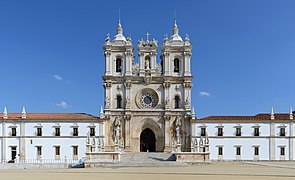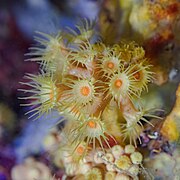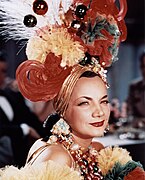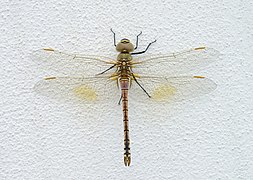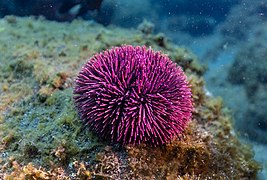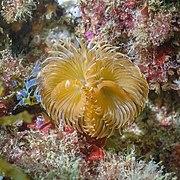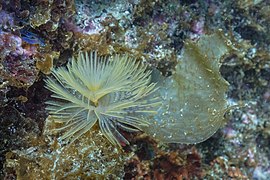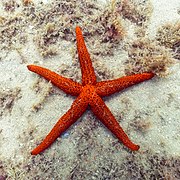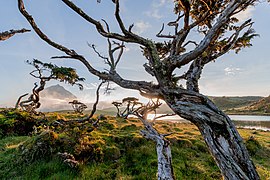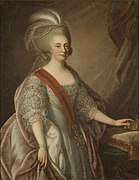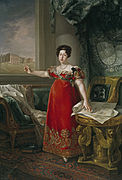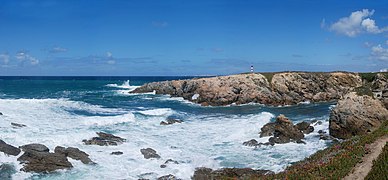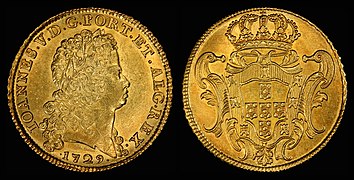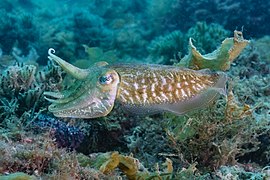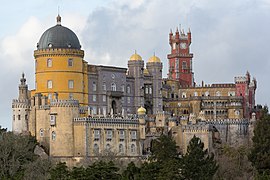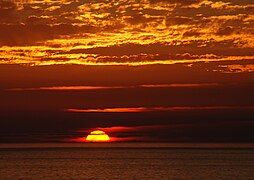Portal:Portugal
Welcome to the Portugal portal  Portugal, officially the Portuguese Republic, is a country in the Iberian Peninsula in Southwestern Europe. Featuring the westernmost point in continental Europe, Portugal borders Spain to its north and east, with which it shares the longest uninterrupted border in the European Union; to the south and the west is the North Atlantic Ocean; and to the west and southwest lie the Macaronesian archipelagos of the Azores and Madeira, which are the two autonomous regions of Portugal. Lisbon is the capital and largest city, followed by Porto, which is the only other metropolitan area. The western part of the Iberian Peninsula has been continuously inhabited since prehistoric times, with the earliest signs of settlement dating to 5500 BC. Celtic and Iberian peoples arrived in the first millennium BC. The region came under Roman control in the second century BC, followed by a succession of Germanic peoples and the Alans from the fifth to eighth centuries AD. Muslims conquered the mainland of present-day Portugal in the eighth century, and Islamic rule was expelled by the Christian Reconquista culminating with the final capture of Faro, between 1238 and 1249 AD. Modern Portugal began taking shape during this period, initially as a county of the Christian Kingdom of León in 868 and subsequently as a sovereign Kingdom with the Treaty of Zamora in 1143. As one of the earliest participants in the Age of Discovery, the Kingdom of Portugal settled Madeira and the Azores, and established itself as a major economic and political power, largely through a maritime empire that extended mostly along the South Atlantic and Indian Ocean coasts. The Portuguese were among the first Europeans to explore and discover new territories and sea routes in South America, sub-Saharan Africa, and southern and eastern Asia, establishing a global commercial network of settlements, colonies, and trading posts. Lucrative trade in spices, slaves, and various other commodities enriched the kingdom and fueled a cultural renaissance, but could not stem growing internal political challenges. A dynastic crisis in the early 1580s resulted in the Iberian Union (1580–1640), which unified Portugal under Spanish rule, marking its gradual decline as a global power. Portuguese sovereignty was regained in 1688 following a costly and protracted war, while the 1755 Lisbon earthquake destroyed the city and further damaged the empire's economy. (Full article...) Selected article - Cividade Hill (Portuguese: Monte da Cividade) or Cividade de Terroso Hill with an elevation of 153 metres (502 ft) is one of the two hills next to the city of Póvoa de Varzim in Portugal. Cividade Hill's most notable feature is Cividade de Terroso in the hilltop. It is an ancient Castro culture town, hence the name of the hill that derives from Latin civitas (city). The walled city thrived since 900 or 800 BC, before being conquered and destroyed by the Roman Republic around 138 BC. Due to its urban protohistoric characteristics, the hilltop is considered to be an acropolis by archaeologists. The acropolis is, currently, owned by Póvoa de Varzim City Hall. In the slope there are villages and walled labyrinth-like farm-fields. (Full article...) This is a Featured article, which represents some of the best content on English Wikipedia.
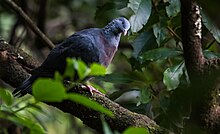 The trocaz pigeon, Madeira laurel pigeon or long-toed pigeon (Columba trocaz) is a pigeon which is endemic to the island of Madeira, Portugal. It is a mainly grey bird with a pinkish breast; its silvery neck patch and lack of white wing markings distinguish it from its close relative and probable ancestor, the common wood pigeon. Its call is a characteristic six-note cooing, weaker and lower-pitched than that of the wood pigeon. Despite its bulky, long-tailed appearance, this pigeon has a fast, direct flight. A scarce resident breeder in laurisilva forests, the trocaz pigeon lays one white egg in a flimsy twig nest. Its numbers fell sharply after human colonisation of the Madeira archipelago, and it vanished altogether from Porto Santo Island. The major cause of its population decline was habitat loss from forest clearance, but hunting and nest predation by introduced rats were also contributory factors. Protection of the laurel forests and a ban on hunting have enabled numbers to increase, so that the species is no longer endangered. (Full article...) General imagesThe following are images from various Portugal-related articles on Wikipedia.
Selected quote -"Hats there are plenty, you fool!"
Chapéus há muitos, seu palerma! This is a Good article, an article that meets a core set of high editorial standards.
 Bombay, also called Bom Bahia or Bom Baim in Indo-Portuguese creole, Mumbai in the local language; is the financial and commercial capital of India and one of the most populous cities in the world. It's also the cosmopolitan city centre of the Greater Bombay Metropolitan Area, and the cultural base of the Bollywood film industry. At the time of arrival of the Portuguese Armadas, Bombay was an archipelago of seven islands. Between the third century BCE and 1348, the islands came under the control of successive Hindu dynasties. The Delhi Sultanate had been ruling the area along with Chaul, New Bombay (Thana) & Damaon; with the local administration at Bassein (Vasai) since the raids of Malik Kafur in the Konkan region and across the Indian subcontinent. This territory in North Konkan along with the Bombay islands were later taken over by the Sultan of Guzerat from 1391 to 1534, when he had declared the end of the suzerainty to Delhi, after the Timurid invasion of it. Growing apprehensive of the power of the Moghal emperor Humayun, Sultan Bahadur Shah of Gujarat was obliged to sign the Treaty of Bassein on 23 December 1534; according to which, the Seven Islands of Bombay, Fort San Sebastian of Bassein in strategic town of Bassein (Vasai), and its dependencies were offered to the Portuguese East Indies. The places were only later officially surrendered on 25 October 1535, by the Sultan of Guzerat. The Portuguese in Goa-Anjediva and Bombay-Bassein were actively involved in the foundation and growth of their Latin Christian religion in Bombay and the neighbouring area. They called the island by various names, which finally took the written form Bom Baim, when the islands were leased to several Portuguese officers during their regime. Portuguese Franciscans and Jesuits built several churches in and around Bombay (Mumbai); the prominent ones are the St Michael's Church at Mahim, St John the Baptist Church at Andheri, St Andrew's Church, the Basilica of Mount Bandra (Bombay) at Bandra, the Gloria Church at Byculla & the Holy Spirit Church Nandakhal at Virar. The Portuguese also built several fortifications around the city like the Bombay Castle, Castella de Aguada (Castelo da Aguada or Bandra Fort) and Madh Fort. (Full article...) Selected Biography -Anthony of Padua, OFM, (Portuguese: António/Antônio de Pádua; Italian: Antonio di/da Padova; Latin: Antonius Patavinus) or Anthony of Lisbon (Portuguese: António/Antônio de Lisboa; Italian: Antonio da/di Lisbona; Latin: Antonius Olisiponensis; born Fernando Martins de Bulhões; 15 August 1195 – 13 June 1231) was a Portuguese Catholic priest and member of the Order of Friars Minor. Anthony was born and raised by a wealthy family in Lisbon, Portugal, and died in Padua, Italy. Noted by his contemporaries for his powerful preaching, expert knowledge of scripture, and undying love and devotion to the poor and the sick, he was one of the most quickly canonized saints in church history, being canonized less than a year after his death. (Full article...) Selected picture - The Assembly of the Republic (Portuguese: Assembleia da República) is the Portuguese parliament; its building in Lisbon is referred to as São Bento Palace (Saint Benedict's Palace).
Did you know -
Portugal topicsPortugal lists
SubcategoriesRecognized content
Featured articlesFormer featured articlesFeatured listsFormer featured listsGood articles
Former good articlesDid you know? articles
Featured pictures
Former featured portalsIn the News articles
Main page featured articles
Picture of the day pictures
Featured topicsNew articlesThis list was generated from these rules. Questions and feedback are always welcome! The search is being run daily with the most recent ~14 days of results. Note: Some articles may not be relevant to this project.
Rules | Match log | Results page (for watching) | Last updated: 2025-03-06 22:36 (UTC) Note: The list display can now be customized by each user. See List display personalization for details.
Things you can doRelated PortalsRelated WikiProjects
Associated WikimediaThe following Wikimedia Foundation sister projects provide more on this subject:
Discover Wikipedia using portals
|























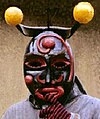



















![Image 43Maios celebration in Madeira island [1] (from Culture of Portugal)](http://upload.wikimedia.org/wikipedia/commons/thumb/e/e1/2011-03-05_03-13_Madeira_045_Santana_%285543431418%29.jpg/120px-2011-03-05_03-13_Madeira_045_Santana_%285543431418%29.jpg)








